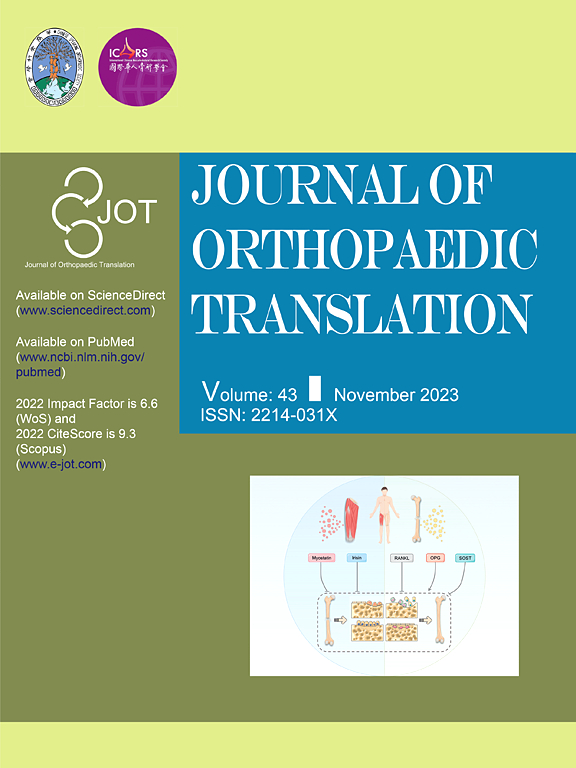Accumulation of advanced oxidation protein products aggravates bone-fat imbalance during skeletal aging
IF 5.9
1区 医学
Q1 ORTHOPEDICS
引用次数: 0
Abstract
Background
Skeletal aging is characterized by a decrease in bone mass and an increase in marrowfat content. Advanced oxidation protein products (AOPPs) accumulate easily with aging and disrupt redox homeostasis. We examined whether AOPPs accumulation contributes to the bone-fat imbalance during skeletal aging.
Methods
Both young and aged mice were employed to assess the changes of AOPPs levels and its contribution to bone-fat imbalance during skeletal aging. Primary bone marrow mesenchymal stromal cells (MSCs) were used to examine the potential role of AOPPs in age-related switch between osteogenic and adipogenic differentiation. Aged mice were also gavaged by non-selective antioxidant N‐acetyl‐L‐cysteine (NAC), followed by close monitoring of the changes in AOPPs levels and bone-fat metabolism. Furthermore, young mice were chronically exposed to AOPPs and then evaluated for the changes of bone mass and marrow adiposity.
Results
The levels of AOPPs in serum and bone marrow were markedly higher in aged mice than that in young mice. Age-related accumulation of AOPPs was accompanied by reduced bone formation, increased marrow adiposity and deterioration of bone microstructure. Reduced AOPPs accumulation by antioxidant NAC leaded to improvement of the bone-fat imbalance in aged mice. Similarly, the bone-fat imbalance was induced by chronic AOPPs loading in young mice. Compared with MSCs from young mice, MSCs from aged mice tended to differentiate into adipocytes rather than osteoblasts and displayed cellular senescence. Exposure of primary MSCs to AOPPs resulted in the switch from osteogenic to adipogenic lineage and cellular senescence. AOPPs challenge also increased intracellular ROS generation by the nicotinamide adenine dinucleotide phosphate (NADPH) oxidase and mitochondria. The antioxidant NAC, after scavenging ROS, ameliorated the AOPPs-induced lineage switch and senescence in MSCs by inhibiting the PI3K/AKT/mTOR pathway.
Conclusion
Our findings revealed the involvement of AOPPs in age‐related switch between osteogenic and adipogenic differentiation, and illuminated a novel potential mechanism underlying bone-fat imbalance during skeletal aging.
The translational potential of this article
Reducing AOPPs accumulation and its cascading effects on MSCs might be an attractive strategy for delaying skeletal aging.

在骨骼老化过程中,高级氧化蛋白产物的积累加剧了骨脂失衡。
背景:骨骼老化的特征是骨量减少和骨髓脂肪含量增加。随着年龄的增长,高级氧化蛋白产物(AOPPs)容易积累并破坏氧化还原稳态。我们研究了在骨骼衰老过程中AOPPs的积累是否会导致骨脂失衡。方法:采用幼龄和老年小鼠,观察骨老化过程中AOPPs水平的变化及其对骨脂失衡的影响。利用原代骨髓间充质间质细胞(MSCs)研究AOPPs在成骨分化和脂肪分化之间的年龄相关转换中的潜在作用。老龄小鼠给予非选择性抗氧化剂n-乙酰- l-半胱氨酸(NAC)灌胃,密切监测AOPPs水平和骨脂代谢的变化。此外,幼鼠长期暴露于AOPPs,然后评估骨量和骨髓脂肪的变化。结果:老年小鼠血清和骨髓中AOPPs水平明显高于青年小鼠。与年龄相关的AOPPs积累伴随着骨形成减少、骨髓脂肪增加和骨微结构恶化。抗氧化剂NAC减少AOPPs积累,改善老年小鼠骨脂失衡。同样,幼鼠慢性AOPPs负荷也会引起骨脂失衡。与幼年小鼠的MSCs相比,老年小鼠的MSCs倾向于向脂肪细胞而非成骨细胞分化,并表现出细胞衰老。原代间充质干细胞暴露于AOPPs导致从成骨谱系到脂肪谱系的转变和细胞衰老。AOPPs刺激也增加了细胞内由烟酰胺腺嘌呤二核苷酸磷酸(NADPH)氧化酶和线粒体产生的ROS。抗氧化剂NAC在清除ROS后,通过抑制PI3K/AKT/mTOR通路,改善了aopps诱导的MSCs谱系切换和衰老。结论:我们的研究结果揭示了AOPPs参与与年龄相关的成骨分化和脂肪分化之间的转换,并阐明了骨骼衰老过程中骨-脂肪失衡的一种新的潜在机制。本文的翻译潜力:减少AOPPs的积累及其对间质干细胞的级联效应可能是延缓骨骼衰老的一种有吸引力的策略。
本文章由计算机程序翻译,如有差异,请以英文原文为准。
求助全文
约1分钟内获得全文
求助全文
来源期刊

Journal of Orthopaedic Translation
Medicine-Orthopedics and Sports Medicine
CiteScore
11.80
自引率
13.60%
发文量
91
审稿时长
29 days
期刊介绍:
The Journal of Orthopaedic Translation (JOT) is the official peer-reviewed, open access journal of the Chinese Speaking Orthopaedic Society (CSOS) and the International Chinese Musculoskeletal Research Society (ICMRS). It is published quarterly, in January, April, July and October, by Elsevier.
 求助内容:
求助内容: 应助结果提醒方式:
应助结果提醒方式:


